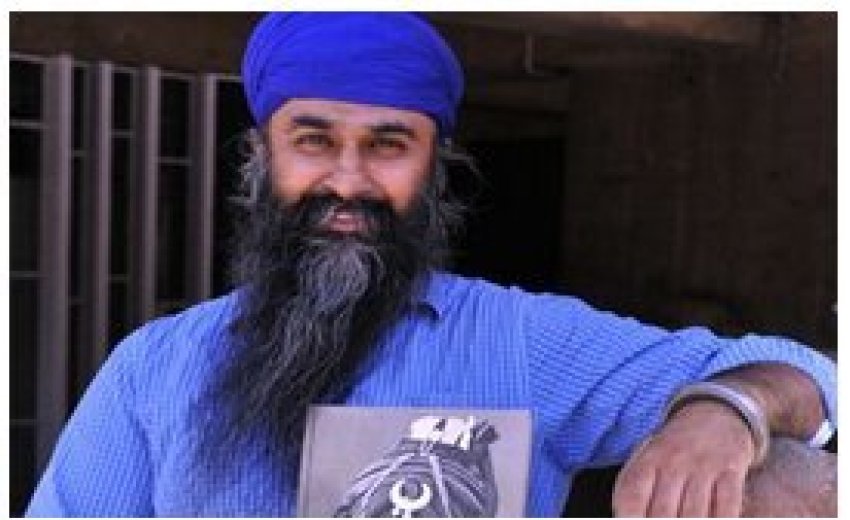 UK-born and brought up Parmjit Singh’s inspiration to explore his roots came when he was in his mother’s womb, he says, since his mother would read Sikh history voraciously then. In stark similarity, the nature to defend and protect, which led to the creation of a warrior community, is in a
Sikh’s blood.
UK-born and brought up Parmjit Singh’s inspiration to explore his roots came when he was in his mother’s womb, he says, since his mother would read Sikh history voraciously then. In stark similarity, the nature to defend and protect, which led to the creation of a warrior community, is in a
Sikh’s blood.
Parmjit’s curiosity about the events and circumstances in history that led to the formation of the ‘saint-soldier’, ended up in a thick compilation, Warrior Saints — Four Centuries of Sikh Military History (Vol.I), the India launch of which took place last month at Government Museum and Art Gallery, Sector 10, Chandigarh.
While the book’s London launch was simultaneously coordinated by its other author, Amandeep Singh Madra, the event in the city was marked by the presence of Lt Gen (Retd) Kartar Singh Gill as the chief guest.
Published by UK-based Kashi House, a not-for-profit publishing group co-founded by Parmjit, the book is a reprint of the 1999 volume, Warrior Saints, though with extensive additions. “The book’s title comes from the name of the tenth Sikh Guru, Guru Gobind Singh, and it is dedicated to sharing knowledge about the Sikh history,” says Parmjit, 40, who was a chartered accountant in London before he realised his calling, left his job and plunged completely into research and propagation of Sikh history. “Our first book was released at an exhibition at the Victoria and Albert Museum, UK, on the occasion of the 300th birth celebrations of the Khalsa. Since the first edition was sold out, we decided that there was a need of storytelling that is more relevant to the younger generation.”
Driven by passion, the two authors began their quest, involving years of travel, laborious fact-finding and data collection from sources ranging from the written records and visual archives in Britain to artefacts preserved the world over. Thus came into existence a book that would span a period of early tradition, beginning from the age of the ten Sikh Gurus, creation of the Sikh Misls, the Sikh Raj and its fall. “It was necessary to create two volumes because the British Raj brought about a break in tradition,” explains Parmjit, whose roots lie in village Narangwal, Ludhiana, adding that the second edition is expected to hit the bookstalls by October this year.
Interestingly, Parmjit’s journey into the history of the celebrated martial race was not a natural consequence of an inquisitive young man in a foreign land. “When someone asked me which village in Punjab I belonged to, I didn’t have an answer,” confesses Parmjit. In wonderment of who, if any, were the custodians of tradition and if the warrior tradition existed in the present times, Parmjit embarked on a journey that took him from a state of complete oblivion to contributing to the compilation of four books: Golden Temple of Amritsar: Reflections of the Past (1808-1959), Sicques, Tigers or Thieves and In the Master’s Presence – The Sikhs of Hazoor Sahib.
Targeted for “anyone who wants to learn about the Sikh warriors,” the book includes rare paintings, pictures and illustrations that are as enlightening as enigmatic. “We have used the earliest war photograph of the capture of Sikh cannons at Ambala in 1849,” informs Parmjit, while sharing details about the most awe-inspiring cover photo of a regal-looking Nihang bodyguard serving in the Nizam of Hyderabad’s irregular Sikh Army (1865).
“Most history books are political narratives. But, we are not political, rigid or preachy. The culture must survive in its original form. I believe that it calls out to us and we owe to our tradition to keep it alive. There is a divine hand helping us,” he signs off.
Priced at R3,500, Warrior Saints — Four Centuries of Sikh Military History (Vol I) is available at book stands.
Kashi House: A Sikh creative media body
Throwing light on Kashi House, the UK-based publishing house of which Parmjit Singh is one of the founding directors (the other being Sukhdeep Singh) the author says it was formed in order to create platforms for other creatives to join in and help spread knowledge on Sikh history.
“We’re happy amateurs,” declares Parmjit, adding that the house has no owners or shareholders and the profits, therefore, are used for the publishing of the next book. “There are currently six other British Sikhs running the body, who are all from different professions and of different ages,” he says. Next, Parmjit wants to make a film on Sikh history, “because films inspire people the most”.

